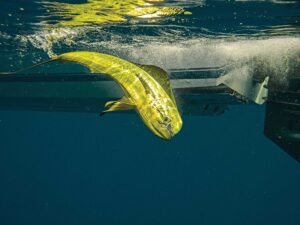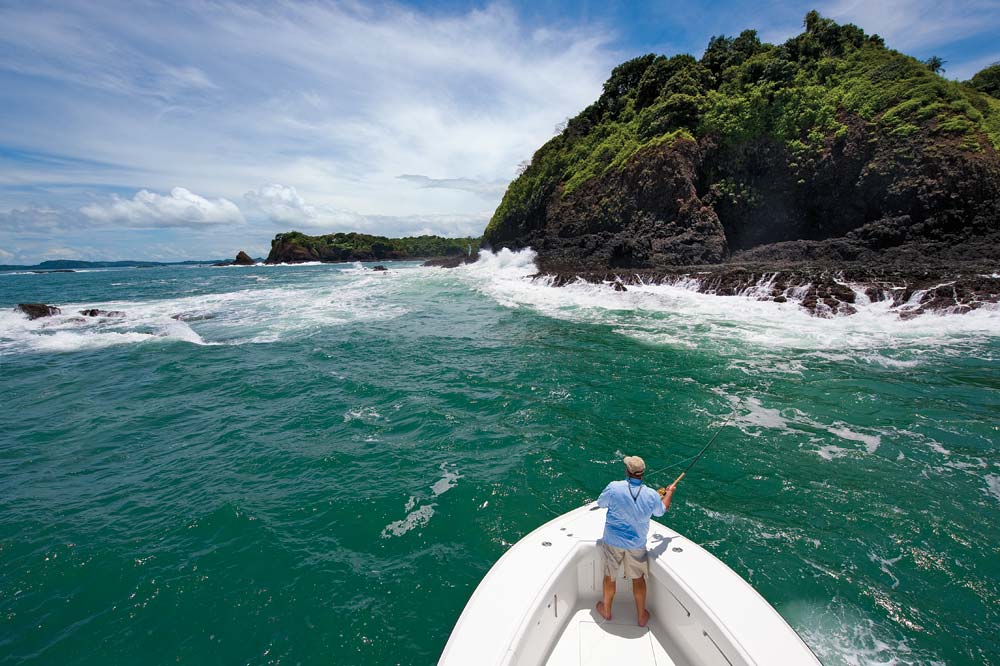
A note from my angling partner and fellow planetary traveler Jeffrey Cardenas came as a surprise and made me blink. “Let me ask David if he would like to join me,” Cardenas had responded in an e-mail he’d sent to Carter Andrews, director of sport fishing at Islas Secas. I knew from our past adventures with Andrews that he had a nose for the best fishing on earth, and at this point I was thinking, Fly-fishing in Panama — now this I can handle.
Andrews has put the all of the pieces together to offer an incredible angling paradise for adventurous fly-fishermen at Islas Secas.
The island is located 25 miles from Boca Chica, Panama, in the Gulf of Chiriqui, which is within the larger Coiba National Park & Marine Preserve.
The Gulf of Chiriqui is influenced by five major oceanic currents, with a potential 16½-foot tidal exchange, making it an ideal spot for marine life to congregate. The pelagic species are here for the food, and the resident fish have no reason to leave.
A vibrant seafaring culture has existed here for centuries unknown, and in ancient times, magnificent pearls were harvested from the ocean floor around Islas Secas by native free divers. Legend has it that the souls of the divers who perished collecting the “tears of the sea” can still be heard throughout the islands. Just like the divers, Cardenas and I were on a quest to find treasure.
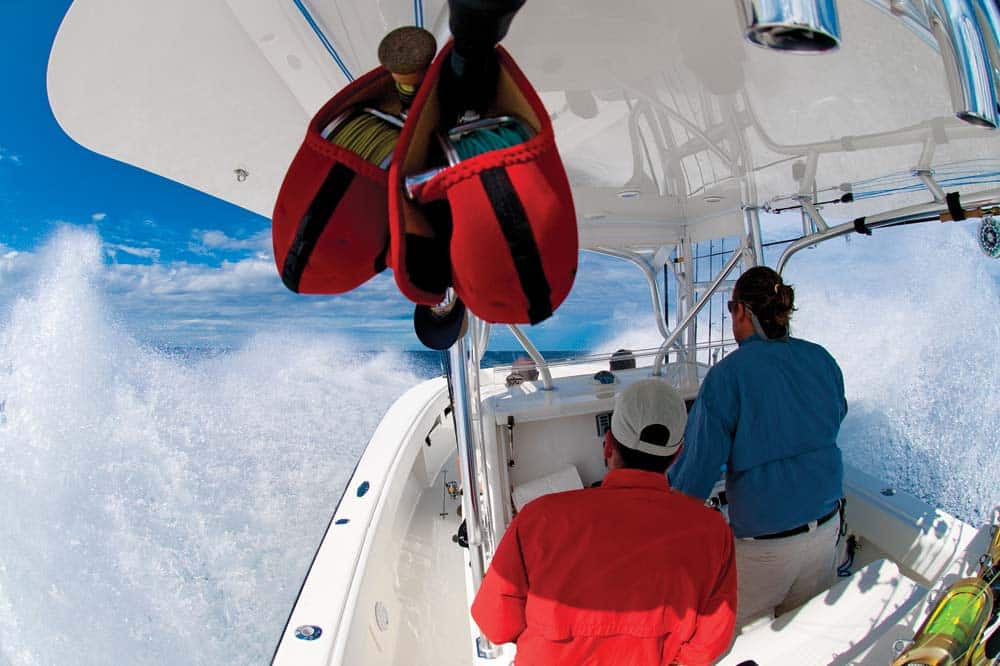
Dancing With the Dog
Andrews swung the cast net from as far behind him as he could, and it spun like a wheel as it opened. It landed with a whoosh over the nervous water, and before long we had enough threadfin herring and anchovies wriggling in the baitwells to make any mate’s arms sore. With a full well, the SeaVee responded as Capt. Antonio “Kid” Murray nudged the sticks, and with that, we were making our way out of the inlet, guarded on either side by towering volcanic cliffs shrouded in tropical green.
A large volcanic outcropping loomed close enough for us to hear the three-foot swell muscle through and around the barrier rocks protruding from the water. Kid carefully nosed the long open bow of the boat close enough to the edge of the boulder field for us to cast, and his first mate, Juan Spragge, didn’t need any direction or encouragement to pitch chummers to stir things up. The first several skittered across the surface without harm, but the next handful weren’t so lucky. In the blink of an eye, two of the three freebies disappeared into brick-red-colored boils. Fish the size and shape of carry-on luggage had inhaled 6-inch anchovies like popcorn shrimp. As I reached for my 12-weight outfit, my mind was racing, along with my heart — these fish were a chip shot away, and they obviously brought their appetite.
Andrews instructed me to make a cast as soon as the fish ate a live bait. Simple enough: A fish shows, and I drop the fly on the target, strip the fly, fight the fish, land it and take a picture.
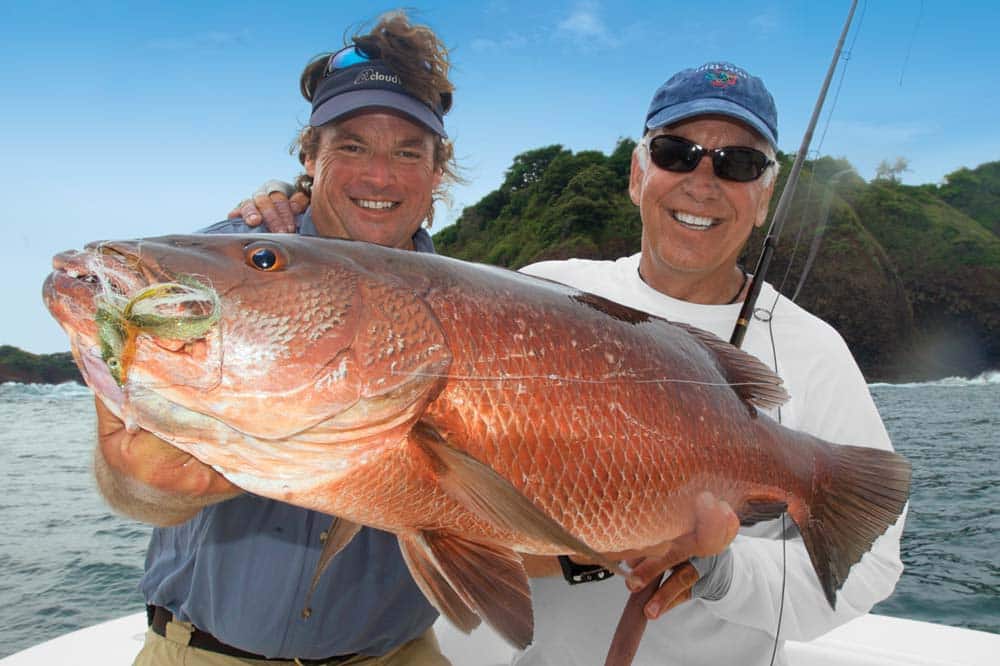
The next baitfish splashed down and traveled two feet to the left, and in what seemed like slow motion, the color of the water under the bait turned rusty red. I gulped and made my presentation. I stripped the fly about a foot, and just before I made my second strip, the fly was intercepted by a thick-headed cubera snapper. With one kick of its tail, it disappeared into the depths. As the line came tight, Kid hit the throttle in reverse to back us out of the cover before the snapper could bury its head and the leader in the craggy bottom. I clamped down on my reel and held on for all I was worth in an attempt to drag this gladiator into open water. With the rod pointed almost straight at the fish, I had direct pressure from the boat, which was of no consequence to the chunky snapper. When the leader parted, I nearly fell over from the release of tension.
Cardenas stepped up to bat as I began tying on a new tippet and fly, feeling beaten. Even though we could see the fights from start to finish, had the right flies and could get the flies to the fish, we both knew that our angling skills would have to be tack-sharp to win this game.
Cardenas, who rarely misses, fixed his eyes on his target and made a cast. The fly landed and was almost gone before moving at all, taken by what was clearly a bigger cubera than the first one. Kid hit the gas to back out, and Cardenas braced for the ensuing tug of war. With every ounce of strength, he bent the rod all the way into the grip, giving up nothing. The rod shook violently and exploded in his hands, and with that, it was my turn to do battle once again.
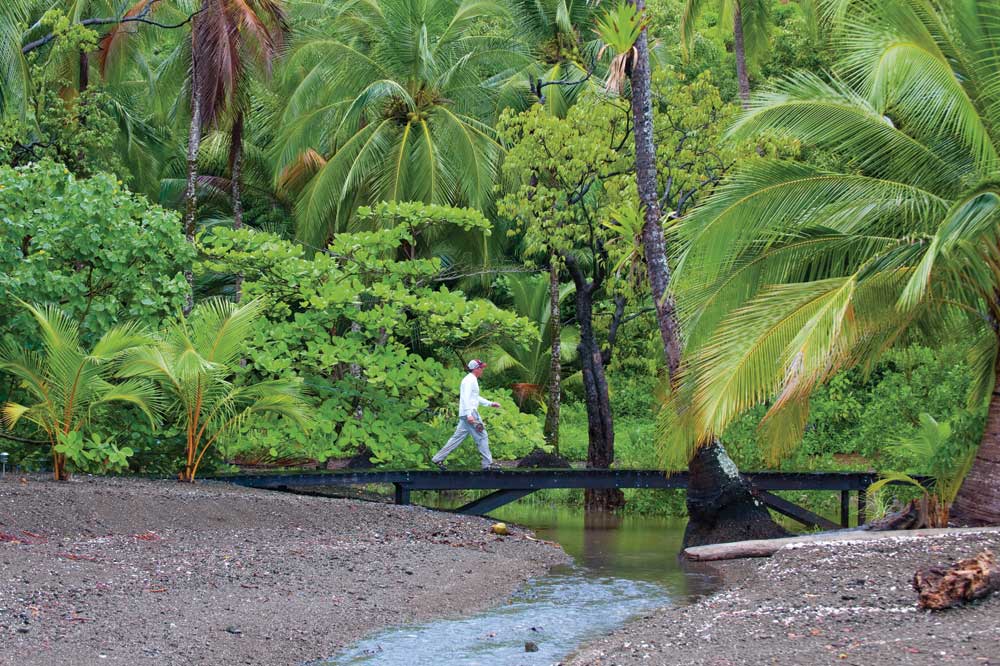
I cut the 50-pound tippet and replaced it with 65-pound fluorocarbon, thinking that a stronger leash would tame the beast. I was wrong — my second hookup ended the same way the first one had.
As I rerigged, I heard Cardenas whoop and curse in defiance as the big Suzukis did their job and backed us out of and away from the impenetrable cover. More clashed words from the bow, then yelling and then, finally, just the sound of fish-fighting, of giving and taking. I was up in time to see a close-quarters battle with a fish that was amazingly powerful and determined. With the brute never more than 60 feet away, this was a knock-down, drag-out war of wills. After years of fighting big fish all over the saltwater world, Cardenas was more than prepared for this kind of contest. Minutes later Kid’s second mate, Billy Clair, gilled the 40-pound cubera and hoisted it into the cockpit for a better look. I cannot say that it was a beautiful fish in the pretty sense, but it was beautifully suited for being at the top of the food chain in this inshore world.
I cast to and hooked several more big snappers and lost some great-looking flies and about 20 feet of tippet before our chances were over. The tide swapped ends, and we were out of baits and needed a new plan for the following day.
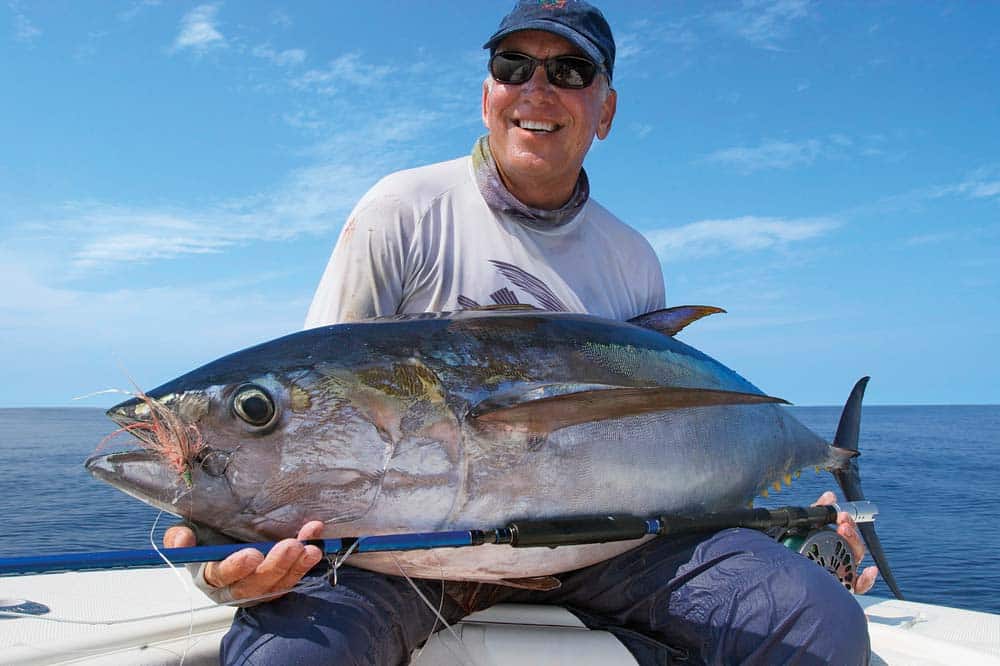
Double Trouble
The following morning, Cardenas and I stepped aboard the gleaming 34-foot SeaVee once again. Greetings from Andrews, Kid and Clair were more than welcome to us high-hoped anglers anxious to begin our search for signs of yellowfin tuna feeding near the surface.
Cruising over the soft swells and heading to Hannibal Bank, we all had our eyes trained on the horizon for birds and any debris that might signal tuna on the feed. Andrews flipped on the radar to help us find man-of-wars and flocks of gannets beyond our vision. Sure enough, there it was, a solid red blob about 2½ miles away identifying concentrated bird action.
Kid pushed the throttles down, and in no time we were three casts away from birds wheeling and diving on baits. The surface was erupting as if bombs were going off. Tuna were slashing violently at the bait that was balled up above them and below the birds. As the center-console glided into casting range, Cardenas and I stripped line from reels as fast as we could, me in the stern and Cardenas in the bow. The boat settled, and we both made casts as far as we could into the frenzy. Strip, strip, strip — no hookup.
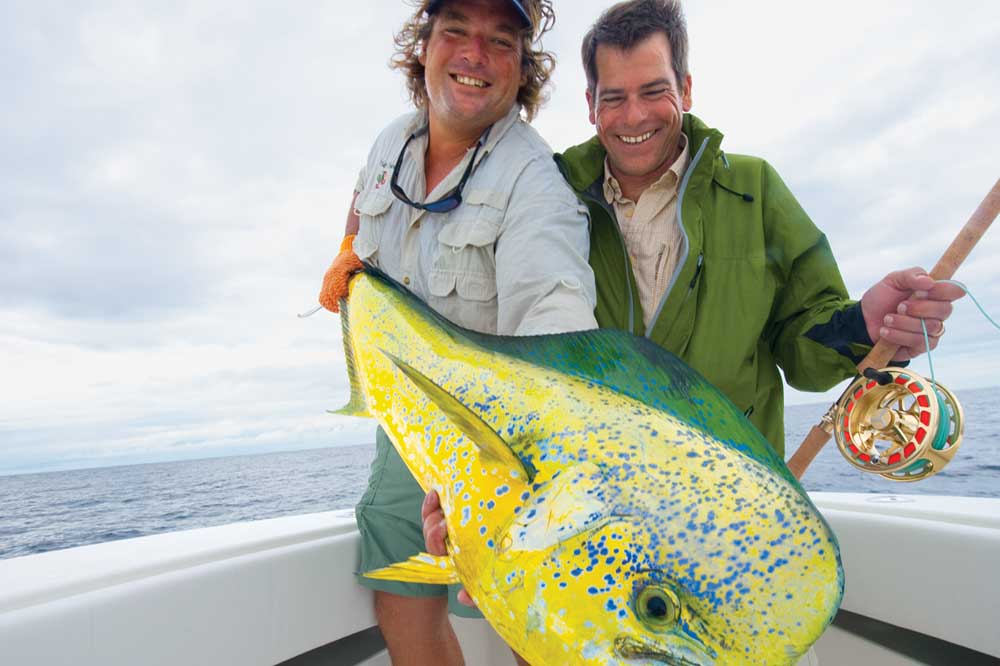
As sure as we were that the tuna had made an exit to the depths, Andrews quickly noticed that the bait had taken up residence under the boat and the tuna were still below them flashing through the blue water.
Kid was on the helm up top and took direction from Andrews to slowly retreat from the baitball to let the tuna push the baits back to the surface and our flies. Sure enough, after only seconds, the big yellowfins returned to the surface once again, churning the water white while murdering anchovies that now had nowhere to hide.
Frantically casting into the mob, we were again left stripping in our flies. After only one cast, the bait had hustled back to the shadow of our hull, with the tuna down deep, still feeding full-bore. Again Andrews gave the gentle command to Kid to back out slowly, and again the mayhem started on the surface. Kid bumped us forward into range, and once more Cardenas and I launched shots into the chaos of silver rockets without getting bit.
The bait took refuge under the boat again, and Andrews instructed the helmsman to back away, leaving the baitball at the mercy of the tuna. For the third time we were in range for casts into the crashing fish.
There are occasions in fishing when you are part of something that is beyond description; time stands still, and you can practically feel the stars lining up. This was one such instance. Cardenas’ rod bucked, and his reel sang that tune we all love to hear. He was solidly attached to a yellowfin. My cast was behind his, and after coming tight on the second strip, I was on the reel. Sweet music and shouts all around — we had a double!
The initial stage of a battle with one of these turbocharged fish is elation and excitement on par with nothing else I have ever experienced. Both tuna made high-speed runs into the backing. With the temp at 90 degrees in the shade, the tussle was taking its toll on our every fiber. We were gaining and losing line but always putting on maximum heat. Slowly the fly lines came into sight. Cardenas was really putting the hickory to his fish as Kid and Clair hovered nearby with the gaffs. Words of encouragement and coordination drifted back to me as Cardenas’ fish came closer. I was still struggling with my fish as it retook the fly line out of sight. My arms were numb, my hands refused to operate properly, and my back was feeling the strain.
Into my dreamy world came the sounds of victory from the bow as Cardenas’ big tuna landed on the deck, banging its tail wildly. All hands were whooping it up at the conclusion of the first half of the double. I was still in the saddle and showing signs of wear. Through coaching from Andrews and Clair, I was pushed to put the heat on this stubborn combatant I had yet to even see. A dry throat, aching muscles and sweat stinging my eyes all made me doubt that I would ever beat this beast.
Pumping, reeling, pumping, reeling, a little at time, I was gaining, and the fly line was in sight through the clear water below, re-energizing my effort. Finally, there it was, with the luster of a pearl, still 70 feet down, slowly gliding in a long arch. It was near the end of its resistance. I looked at my hands that I could not feel and willed them to turn the reel handle a few more times. The glimmering tuna came out from under the stern and leveled off near the surface. I could plainly see its big eye, and finally, the tuna was hoisted over the gunwale onto the deck, still fighting back.
Cardenas was there congratulating me, as I was him. I wanted only to start breathing again and regain my composure. We were joyous in our fine fortune and what we had shared. Cleaned up and washed off, we went back to looking for birds and more “tears of the sea.”
Tackle Guide
Rods: You will want to bring a quiver of rods ranging from 9- to 18-weight. Because opportunities are aplenty, anglers should be prepared for skipjack, dolphin, bluefin trevally, cubera snapper, roosterfish, tuna, sailfish, marlin and more.
Reels: The rule for reels is no different than the rule for rods. You’ll want to have a wide selection of reels with strong, smooth drags that can handle multiple species with different fighting styles.
Lines: For most of the inshore fishing, I used a floater. Intermediate lines are OK but make properly fishing a popper or gurgler tricky. For searching deeper waters, lines in the 400- to 500-grain range work great.
Leaders: Leaders with a 3- to 4-foot butt section of 60- to 80-pound hard mono looped to 20- to 60-pound fluorocarbon should cover you for most situations. However, if you plan on fishing for billfish according to IGFA rules, your leaders need to be carefully constructed with double Biminis, 20-pound-class tippets and a shock tippet measuring 12 inches or less.
Flies: The most abundant food source in the Gulf of Chiriqui is baitfish ranging from 4 to 6 inches long. Patterns like Deceivers (in olive and white or in blue and white), which imitate anchovies, herring and sardines, work well. My favorite is a fly I call the Yakking Baitfish. It’s a yak-hair and synthetic blend with a bleeding under gill and eyes. I like 2/0 to 5/0 super-strong, super-sharp hooks.

